September 15, 2016
Flooring Material Trends
Over the past 12 years, Home Innovation has been closely tracking the many changes in the popularity of flooring types in new homes. The biggest winners have been Solid Hardwood and Engineered Hardwood. While carpeting still remains the leader, it has fallen from 60% to 40% overall share. Vinyl flooring has also lost much of its former market share—primarily sheet vinyl—but vinyl has received a boost from the growing popularity of the luxury vinyl tile market. The market for ceramic tile in new homes has increased modestly over the past decade.
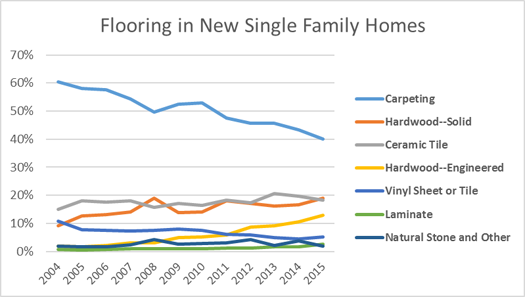
Current New Home Market for Flooring
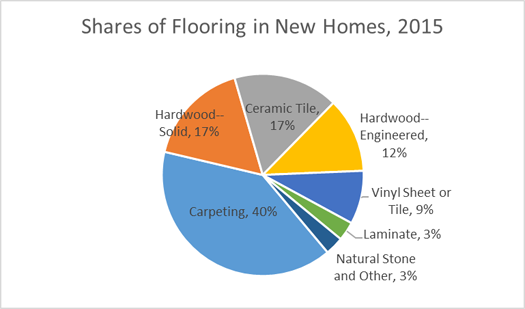
- More than 2 billion square feet of flooring was installed in new U.S. homes in 2015.
- Carpeting has been the leading material for decades and is the far-and-away favorite in bedrooms for all types of housing.
- Ceramic Tile and Solid Hardwood are tied at the #2 spot, with Engineered Hardwood flooring in the 4th position.
- Laminate, which is very popular with consumers in the flooring replacement market, has just begun to take hold in new homes and is now at 3%.
Regional Differences in Flooring Preference
- Regionally, Solid Hardwood is most popular in New England homes (52%) and least popular in new homes in Pacific states (10%).
- Carpeting is most popular in the Midwest, representing slightly more than 50% of all new home flooring. Carpeting is least popular in New England with 18% in new homes there.
- Tile is most popular in the Mountain states, particularly in the desert south, with about a third of all new home flooring. Tile is least popular in the Midwest with slightly more than 10% share.
- Use of Engineered Hardwood is highly regional as an alternative to Solid Hardwood—it does very well in many Southern states where concrete slab floors are popular; in the Pacific Northwest; and in some intermountain hotspots like Colorado, Utah, and New Mexico.
Flooring Trends and Rooms
The growth in popularity of the “wood-look” can be seen in the growth of three categories: Solid Hardwood; Engineered Hardwood; and Laminate. In the past 12 years, wood flooring has grown in all areas of the house. It has at least doubled its popularity in all rooms, and in many it has grown three-, four-, five-fold, or more. Wood flooring is most popular in the Dining Room accounting for 69% of all new flooring there, but not very popular in Bathrooms—only at 5% of all bathroom flooring in 2015.
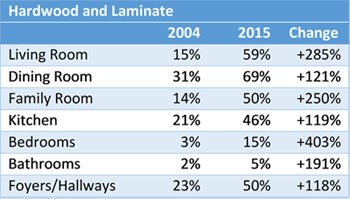
Vinyl has traditionally been most popular in potentially wet and messy areas of the home—i.e., the kitchen and bathroom—due to its water-resistance and ease of maintenance. However, its share has fallen by half in these rooms, losing primarily to Ceramic Tile. Interestingly, Vinyl fell only slightly in the Dining Room, where it maintained about 4% share.

Ceramic Tile, on balance, has grown modestly in popularity in the past 12 years. Use in some areas of the house has grown, while in others Tile has lost share. In the Living, Dining, Family, and Bedrooms, where carpeting has historically been most popular, Ceramic Tile has made large gains. Ceramic Tile has also made big gains in Bathrooms, taking share primarily as an upgrade from Vinyl. Ceramic Tile has lost some of its edge in the Kitchen and Foyers/Hallways due to the encroachment of wood flooring.

Carpeting has lost ground in nearly every room of the house—one exception is in the Kitchen, where it has never had any meaningful volume. The biggest losses came from the encroachment of “hard” flooring—Tile, Hardwood, and Laminate—into the Living, Dining, and Family Rooms, as well as Foyers/Hallways. The popularity of Carpeting dipped the least in Bedrooms, where it’s managed to maintain nearly 80% of bedrooms in 2015.
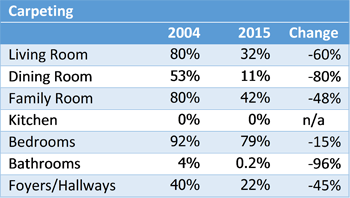
Flooring by Price-Point of Homes: Starter, Moveup, Luxury
Carpeting is the most popular flooring type in all three price-point categories for single-family homes—Starter, Move-up, and Luxury.
All types of flooring were reported in each of the three price-point categories, but some materials are more prevalent. Looking at shares of materials by price-point gives an indication of how the market perceives each of the materials as low-, medium-, or high-end. For example, Solid Hardwood is about three times as likely to be found in Luxury homes as in Starter homes, whereas Engineered Hardwood is only about 50% more likely to be found in Luxury homes compared to Starter homes. In contrast, Vinyl is about five times as likely to be found in a Starter home than a Luxury home and Laminate flooring is more than three times as likely to be used in Starter homes compared to Luxury homes.
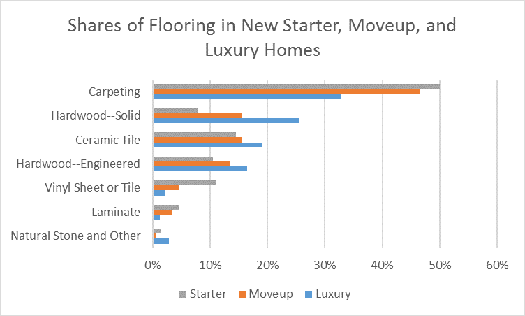
Back to Top